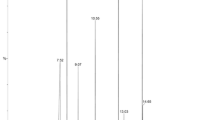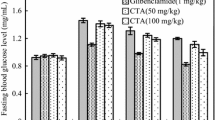Abstract
Oxidative stress is involved in diabetes mellitus and its complications. Since diabetes is a stress-related disorder, supplementation with antioxidants may improve the condition. The purpose of this study is to know the effect of oral administration of selenium on blood glucose and its influence on gliclazide induced hypoglycaemia/antihyperglycaemia in normal and alloxan-induced diabetic rats. Albino rats of either sex were divided into three groups of six each. Group-I/II/III were treated with selenium 1/2 TD (0.9 μg/200 g rat)/TD (1.8 μg/200 g rat)/2TD (3.6 μg/200 g rat), respectively. Later group II was treated with gliclazide TD (1.44 mg/200 g rat)/selenium TD + gliclazide TD with a washout period of 1 week between the treatments. Diabetes was induced by alloxan monohydrate 100 mg/kg body weight i.p. A group of six rats showing fasting blood glucose levels ranging from 175–250 mg/dl were selected for the study. Rats were treated with selenium TD, gliclazide TD and selenium TD + gliclazide TD with a washout period of 1 week between the treatments. Selenium 1/2 TD and TD produced hypoglycaemia while 2TD produced hyperglycaemia. The combination of selenium TD with gliclazide TD, significantly enhanced the glucose lowering effect of gliclazide in normal and diabetic rats.
Similar content being viewed by others
References
Kingh H, Aubert RE, Heiman WH: Prevalence: numerical estimates and projections. Global burden of diabetes, 1995–2025. Diabetes Care 21: 1414–1431, 1998
Harris MI, Flegal KM, Cowie CC, Eberhardt MS, Goldstein DE, Cittle RR, Miedmeyer HM, Byrd, Holt DD: Prevalence of diabetes, impaired fasting glucose and impaired glucose tolerance in U.S. adults. The third national health and nutrition examination survey 1988–1994. Diabetes Care 21: 518–524, 1998
Ziegler P, Drouin P: Hemobiological properties of gliclazide. J Diabetes Complicat 8(4): 235–239, 1994
Collier A, Wilson R, Bradley H, Thomson JA, Small M: Freeradical activity in type diabetes. Diabetic Med 7: 27–30, 1990
Nourooz-Zadesh J, Rahimi A, Tajaddini-Sarmadi J, Tritschler H, Rosen P, Halliwell B, Betterdige DJ: Relationships between plasma measures of oxidative stress and metabolic control in NIDDM. Diabetologia 40: 647–653, 1997
Sreemantula S, Kilari EK, Vardhan VA, Jaladi R: Influence of anti oxidant (L-ascorbic acid) on tolbutamide-induced hypoglycaemia/anti hyperglycaemia in normal and diabetic rats. BMC endocrine disorders 5: 2, 2005
Douillet C, Tabib A, Bost M, Accominoth M, Broson-Chazot F, Civatti M: Selenium in diabetes: Effects of selenium on nephropathy in type-I streptozotociun induced diabetic rats. J Trace Elem Exp Med 12: 379–392, 1999
Lawrence DR, Bacharach AL (eds.): Evaluation of drug activities: Pharmacometrics. Vol. 1, Academic Press, New York, 1964
Trinder P: Determination of glucose in blood using glucose oxidase with an alternative oxygen acceptor. Ann Clin Biochem 6: 24, 1969.
Lawrence JC, Jill SG, Eric PD, Joyle AD, Donald DL, Mark AY: Effect of antioxidant treatment on streptozotocin induced diabetic rats on endoneural blood flow, motor nerve conduction velocity and vascular reactivity of epineural arterioles of the sciatic nerve. Diabetes 50: 1927–1937, 2001
Oberly LW: Free radicals and diabetes. Free Radic Biol Med 5: 113–124, 1988
West IC: Radicals and oxidative stress in diabetes. Diabetic Med 17: 171–180, 2000
McNeill JH, Delgatty HL, Battell ML: Insulin like effects of sodium selenate in STZ induced diabetic rats diabetes 40(12): 1675–1678, 1991
Ghosh R, Mukharjee B, Chatterjee M: A novel effect of selenium on streptozotocin induced diabetic mice. Diabetic Res 25(4): 1165–1171, 1994
Sheng Xq, Huang Kx, Xu HB: New experimental observation on the relationship of selenium and diabetes mellitus. Biol Trace Elem Res 99(1–3): 241–253, 2004
Osamu Ezaki: Insulin like effects of selenium in rat adipocytes. J Biol Chem 265(2): 1124–1128, 1990
Riley V: Adaptation of orbital bleeding technique to rapid serial blood studies. Proc Soc Exp Biol Med 104: 751–754, 1960
Heikkila RE: The prevention of alloxan-induced diabetes in mice by dimethyl sulfoxide. Eur J Pharmacol 44(2): 191–193, 1977
Lizuka Y, Sakhurai E, Hichi N: Effects of selenium on serum glucose and insulin levels in diabetic rats. Nippom Yakurigakuzashi August 100(2): 151–156, 1992
Madar J, Dicter N, Tirosh O: Selenium antioxidant activity may impair glucose metabolism in rats. 18th International Diabetes Federation Congress, August 24–29, 2003, Paris, France. OP 20 nutrition 155
Viggneri R, Pezzino V, Wang KY: Comparison of the in-vitro effect of biguanides and sulfonylureas on the insulin binding of its receptors in target cells. J Clin Endocrinol Metab 54: 95–100. 1982
Campbell DB, Lavielle R, Nathan C: The mode of action on clinical pharmacology of gliclazide: A review. Diabetes Res Clin Pract 14(Suppl 2): S21–S36, 1991
Chiasson JL, Hamet P, Vercly M: The effect of Diamicron(R) on the secretion and action of insulin. Diabetes Res Clin Pract 14: S47–S51, 1991
Ma A, Kamp M, Bird D: The effects of long term gliclazide administration on insulin secretion and insulin sensitivity. Aus NZ J Med 19: 44–49, 1989
Vanhaeften TW, Vaneman TF, Gerich JE: Influence of Gliclazide on glucose stimulated insulin release in man. Metabolism 40: 751–755, 1991
Wajchenberg BL, Santomano ATMG, Porrelli RN: Effect of sulfonylurea (gliclazide) treatment on insulin sensitivity and glucose mediated, glucose disposal in patients with non-insulin dependent diabetes mellitus (NIDDM). Diabetes Res Clin Pract 20 : 147–154, 1993
Ruhe RC, McDonald RB: Use of antioxidant nutrients in the prevention and treatment of type-II diabetes. J Am Coll Nutr 20(5): 363S–369S, 2001
Abdel-Wanhab YH, O'Harte FP, Mooney MH, Barnett CR, Flatt PR: Vitamin C supplementation decreases insulin glyclation and improves glucose homeostasis in obese hyperglycaemic (ob/ob) mice metabolism 51: 514–517, 2002
Author information
Authors and Affiliations
Corresponding author
Rights and permissions
About this article
Cite this article
Satyanarayana, S., Sekhar, J.R., Kumar, K.E. et al. Influence of selenium (antioxidant) on gliclazide induced hypoglycaemia/anti hyperglycaemia in normal/alloxan-induced diabetic rats. Mol Cell Biochem 283, 123–127 (2006). https://doi.org/10.1007/s11010-006-2387-2
Received:
Accepted:
Issue Date:
DOI: https://doi.org/10.1007/s11010-006-2387-2




